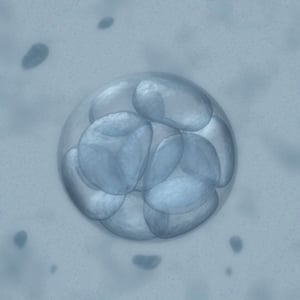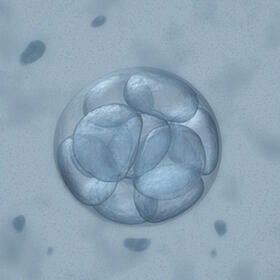We are experiencing a very high volume of calls and messages and ask for your patience. We will answer your portal messages within 48 hours.
We are experiencing a very high volume of calls and messages and ask for your patience. We will answer your portal messages within 48 hours.


“My doctor said that my embryos looked picture-perfect, yet they failed to implant – why did this happen?”
This is the question in the minds of women who undergo IVF failure, and this becomes a particularly nagging doubt when they face multiple IVF failures. Many women naturally think that their uterus is defective or their body is not good enough to accept the embryo-- that their uterus is rejecting the transferred embryo, or their own body is killing it. After all, fertilization happened in the lab, the embryo grew well in vitro, and they even saw their embryo (remember, you must always see your embryos and ask for photos before embryo transfer!).
The embryologist assured them that they looked perfect, and they’ve read lots of IVF success stories of women who got pregnant with such good embryos. As a result, they naturally come to the conclusion that good embryos are meant to implant – and if they didn’t, this clearly means there’s a problem with their uterus or their body.
Sound familiar? Low self-esteem caused by infertility makes it easy for you to jump to this conclusion and beat yourself up. A bad situation is often made worse by relatives telling you the embryo must have “fallen out” because you did not rest sufficiently; or that the cycle failed because you are too stressed or have too much “body heat”. This is why many women who undergo repeated implantation failure opt for surrogacy.
This article has been written to help you understand what causes repeated implantation failure (is the cause really known? and which is the culprit – the seed (embryo) or the soil (uterus)?
When an egg and sperm unite together an embryo is formed (this event takes place in the fallopian tube in your body, and in the IVF lab it takes place in a petri dish which contains nourishing culture medium). The embryo thus formed divides rapidly and reaches the uterus in the blastocyst stage (or is transferred to the uterus on day 3 or day 5 during an IVF cycle).
When in the uterus, the blastocyst starts to communicate with the endometrium (the uterine lining) by secreting protein molecules. If the embryo is competent enough and if the endometrium is receptive, this results in implantation. Implantation is the attachment of the blastocyst stage embryo to the endometrial lining of the uterus, so that it further develops into a baby (imagine planting a seed in the soil).
When a woman undergoes three or more failed IVF attempts (with good quality embryos) or if implantation doesn’t happen even after transferring more than 10 ‘good-looking’ embryos over many cycles, then the woman is said to have “implantation failure”. When an embryo fails to implant, there can only be two logical reasons: the embryo is not good enough (genetically abnormal), or the endometrium is not “receptive” (doesn’t allow the embryo to implant) enough. So, what really causes implantation failure? Please keep reading!
Imagine a farmer who owns a piece of land and wants to cultivate rice. He ploughs and tills the land, making it ready for sowing, finds the right season, and carefully selects the seeds.
This is analogous to how an IVF doctor prepares a woman for undergoing an IVF cycle. He gives hormone injections so that the eggs are collected and fertilized with her partner’s sperm to form embryos (seeds). Hormones (estrogen and progesterone) are also used make the uterus ready for accepting the embryo (just like ploughing the land, adding fertilizers and so on). The woman needs to be in good health (analogous to waiting for the right season to sow the seeds).
When a farmer takes care of all these things and sows the seeds, he expects the seeds to germinate and grow. But what happens when the seeds fail to sprout? There are three main reasons for this happening:
In rare cases, additional factors which prevent growth include improper seeding (difficult or traumatic embryo transfer), or a sudden change to the environment (e.g., an infection in the uterus).
It is a well-known fact that young women fall pregnant quickly when compared to their older counterparts. This is because eggs from older women are more prone to genetic defects, such as aneuploidies (presence of the wrong number of chromosomes), and contain incorrect or insufficient genetic information necessary to build a healthy baby.
When such eggs are fertilized, it leads to the generation of embryos which are genetically incompetent. Either such embryos do not implant and even if they do, the pregnancy ends in early miscarriage. In rare instances, they can also lead to a full-term birth where the newborn has genetic defects.
With the advent of comprehensive chromosome screening, it is now possible to screen all 24 chromosomes (22 autosomes and 2 sex chromosomes) for the presence of aneuploidy (even though the effectiveness of such a technique to increase live birth via ART in clinical practice is still not proven). One such study using CGH showed that 96% of aneuploid embryos failed to implant.
This clearly shows that embryo competency plays a major role in implantation. This is why older women require more attempts than their younger counterparts to succeed with IVF. When an older woman uses donor eggs, her chance of achieving IVF success goes up dramatically! This is irrefutable proof that it is embryo quality which plays a major role in implantation and IVF success.
The importance of soil quality in agriculture is well known. Does endometrium play such a crucial role in embryo implantation? What happens when a fertile seed (genetically competent embryo) is seeded on defective soil (non-receptive endometrium)?
The period during which the uterus is able to receive the embryo (blastocyst) is called the “window of implantation.” The human uterus is receptive only during a short period of time, which is known as “uterine receptivity”. In humans, the receptivity period is between day 20 to day 24 of regular menstrual cycle i.e., 7-11 days after the LH surge that triggers ovulation. (You can calculate the best time for you to get pregnant with this easy-to-use fertility calendar.)
During IVF, embryos are transferred to the uterus either day 3 (embryo transfer) or day 5 (blastocyst transfer) after egg collection (the day of ovulation), which coincides with the “window of implantation” of natural menstrual cycle. During frozen embryo transfer, the day of starting progesterone is taken as the first day of ovulation and embryo transfer is done accordingly.
Human embryo implantation is an enigmatic biological phenomenon – after all, in-vivo experiments are impractical and unethical to conduct; and studies with animal models do not translate well to humans. But it is well-known fact that embryo and endometrium talk to each other using molecular signals, and such cross-talk is necessary for successful implantation. However, no reliable molecular markers for endometrial receptivity have been identified. This makes it difficult to find out whether the endometrium is receptive or not during an IVF cycle.
During IVF, endometrial receptivity is assessed crudely with the help of ultrasound images. Endometrial thickness is measured using ultrasound images, and an endometrium of greater than 8mm, which is trilaminar, is believed to be optimum for embryo transfer.
It is a well-known fact that the endometrium becomes receptive only after progesterone exposure. Progesterone brings about necessary changes in endometrium (converts the endometrium from proliferative to secretory phase) so that it becomes ready to accept the embryo. Recently, frozen embryo transfers are becoming much more successful than fresh embryo transfers in the field of IVF. It is hypothesized that high estrogen concentration in the body during the fresh IVF cycle compromises endometrial receptivity.
There are also many unproved reasons cited for lack of uterine receptivity, which include immunological theories like the presence of high number of uterine NK cells, excessive HLA matching between partners, and blood clotting issues.
The ease with which the uterus can be negotiated for the embryo transfer also plays a pivotal role in achieving successful implantation. If the uterus is hard to access via the cervix (for example, in patients with cervical stenosis), then other embryo transfer methods like ZIFT should be used in order to enhance implantation.
Yes, it can be treated, but only if the reason is known. The one and only well-known, scientifically proven reason for implantation failure is genetically incompetent embryos. If you are a woman of advanced maternal age or if you have premature ovarian aging, even if you get some embryos to transfer during an IVF cycle, many a time they can be genetically abnormal and will not implant successfully.
The irony is many women do not want to accept this fact (after all, it is very difficult to accept that they can’t have a genetic baby) and try to blame their uterus for the failed implantation. As a result, they believe that surrogacy can help them conceive, which is not true!
Doctors make use of their ignorance and “treat” them with many different therapies, which are not evidence-based. I have seen so many women of advanced maternal age subjecting themselves to many useless therapies and ultimately finding success when they finally use donor eggs. So if advanced maternal age or poor ovarian reserve is the cause of failed implantation, the only reasonable solution is to use donor eggs.
If your uterine cavity contains adhesions, fibroids or polyps which interfere with implantation, removing them will help in achieving embryo implantation.
The role of endometrial thickness in successful implantation is still a question. Many women with thin endometrium do have successful implantation, but the scientific literature shows that an endometrium thickness of more than 8mm is optimum for achieving implantation.
The following therapies do not have solid proof for their efficacy and are very speculative:
Doctors should resist offering such treatments. They must make sure that the patient understands that the above-mentioned therapies are not evidence-based and may not be a panacea for their problem.
When an embryo enters the uterus in the blastocyst stage, it initiates molecular cross-talk with the endometrium. Perhaps it says, “Hey, I am here and I want to connect with you. Are you ready to accept me? ” The endometrium senses the signal sent by the embryo and responds accordingly. All this cross-talk happens by releasing appropriate protein molecules. It is believed that if there is some problem with this cross-talk, embryo implantation fails.
It is hypothesized that the endometrium acts as a biosensor of embryo quality. This means if a genetically abnormal blastocyst enters the uterine cavity, the endometrium senses this by the signals sent by the embryo and prevents the implantation of the embryo. So if this biosensor mechanism is defective in some women, they paradoxically become “superfertile”. That is, such women fall pregnant very easily because even genetically abnormal embryos are allowed to attach to the endometrium and establish a pregnancy.
On the other hand, they suffer from recurrent biochemical pregnancies or miscarriages, because even if the genetically abnormal embryo implants, it can’t develop into a healthy baby and gets aborted eventually.
There are also studies which show that even if the endometrium is not optimally receptive, a genetically competent embryo can modify the endometrial environment to make it favorable, so that successful implantation is achieved.
When you talk to a well-experienced IVF specialist, he will say from his practical experience that when women suffer from recurrent implantation failure, most of the time changing the egg can bring about successful implantation and pregnancy!
The endometrium seems to act as a passive recipient. After all, a seed can sprout even in the absence of soil (for example, in women who have ectopic pregnancies, where the embryo implants in the fallopian tube, where there is no endometrium at all) If you are suffering from recurrent implantation failure, please do not blame your uterus if it doesn’t have any obvious defects.
This is an excerpt from our forthcoming, book, The Expert Patient’s Guide to IVF. This being authored by our expert patient, Manju and me.
You can email Manju at manjupadmasekar@yahoo.com
Her blog is at www.myselfishgenes.blogspot.com

Entire Website © 2003 - 2020
Karande and Associates d/b/a InVia
Fertility Specialists
